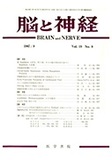Japanese
English
- 有料閲覧
- Abstract 文献概要
- 1ページ目 Look Inside
I.はじめに
近年,脳血管撮影法の進歩普及により各種の脳血管障害の臨床病態像が解明され,これらのなかでも脳動脈瘤や脳動静脈瘤の存在が注目されるようになり,脳神経外科医により各種の積極的手術が行なわれ,その手術成績向上のための努力がはらわれてきている。
他方,脳と同様な神経組織からなる脊髄の血管障害に対してはようやく関心がもたれつつあり,とくに外科的治療の対象となりうる脊髄動脈瘤,動静脈瘤についても,近年診断面におけるミエログラフィー,血管撮影の導入により始めて,より正確な病態像把握が可能となり手術例の増加とともに徐々に解明されつつある現況といえよう。
Spinal arteriovenous aneurysm has been considered as rare vascular disease of nervous system and its incidence is usually rated at 3 to 4 per cent of spinal cord tumor (Therkelsen 1958).
With the presentation of our experienced case of cervical spinal arteriovenous aneurysm which showed recurrent attack of subarachnoid bleeding and being done surgical treatment successfully, several discussions concerning the disease have been performed in relation to previously reported cases.
The following conclusions appear justified :
1) There is no specific distribution in age incidence, but marked predominance in male is pointed out.
2) The elective sites of arteriovenous aneurysm are the dorsal and dorsolumbar while the cervical is rare.
3) There is no charactaristic symptom in arteriovenous aneurysm and it is commonly difficult to differentiate the one from spinal cord tumor, myelitis and arach-noiditis in symptom and sign alone.
4) Although the presence of blood in CSF has clin-ically diagnostic value, it is exceedingly rare in care of arteriovenous aneurysm as usually being expected.
5) When spinal arteriovenous aneurysm, especially in cervical region, present with subarachnoid hemorrhage, it is practically impossible to make a clinical distinction from rupture of cerebral aneurysm. Therefore, ver-tebral angiography should be performed in case of cervicodorsal spinal level.
6) For diagnosis of arteriovenous aneurysm, vertebral angiography and aortography will give the exact pat-tern of the disease and, as a result, it is of great help to decide the indication and method of surgical treat-ment.
7) Untill recently, surgical treatment has generally been considered dangerous for fear of increasing cord damage, and no benefit for the prognosis. However, with use of angiography as diagnostic procedure, such surgical treatment as total removal of arteriovenous aneurysm, ligation of arterial pedicle, sectioning of dentate ligament and laminectomy for externally de-compression will be inclined to do by several inves-tigators.
8) In comparrison with total removal of arteriovenous aneurysm, ligation of arterial pedicles has been a per-fectly innocuous and efficacious procedure. This does diminish the pressure inside the arteriovenous aneurysm and reduces the risk of subarachnoid bleeding resu-lting thrombosis formation and spontaneous cure of the disease.

Copyright © 1967, Igaku-Shoin Ltd. All rights reserved.


